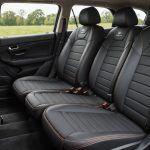Overview of Rear Differential Lock Functionality
A rear differential lock plays a crucial role in enhancing the off-road performance of a vehicle. Essentially, it is a mechanism that prevents the wheels on the rear axle from moving independently of each other. When activated, it locks the rear wheels, allowing them to rotate at the same speed. This feature can be incredibly beneficial for navigating challenging terrains where traction might be compromised.
Importance in Off-road Performance
The primary functionality of a rear differential lock in an off-road vehicle becomes evident when traversing uneven or slippery surfaces. By locking the rear differential, it ensures power is equally distributed to both wheels, optimizing grip and stability. This can be particularly advantageous when a single wheel loses contact with the ground or when managing steep inclines.
Topic to read : What role does vehicle maintenance play in preventing accidents?
Key Features in a Reliable Differential Lock
When evaluating a reliable differential lock, consider its durability and engagement mechanism. Look for locks that provide seamless and smooth operation, even under stress. A robust lock should also offer longevity and minimal maintenance requirements. Pneumatic or electronic controls often enhance reliability, providing ease of use in demanding situations. Additionally, the ability to disengage quickly is vital to transition back to regular driving conditions smoothly. Properly assessing these features ensures efficient performance, prolonging the reliability of your off-road vehicle.
Tools and Equipment Needed for Verification
Verifying a rear differential lock requires specific tools and equipment to ensure accuracy and safety during the process. Firstly, a basic toolkit is essential, including socket wrenches, pliers, and screwdrivers for removing components and accessing the lock mechanism. A torque wrench might be necessary to tighten bolts to the manufacturer’s specifications.
Also to discover : How can I conduct a pre-trip safety check on my vehicle?
For a more in-depth verification process, consider using optional equipment such as a diagnostic scanner for vehicles with electronic differential locks. This tool can provide error codes and system feedback, pinpointing electronic issues that might not be visible to the naked eye.
It is crucial to wear adequate safety gear during verification to prevent injuries. Protective glasses shield your eyes from debris, while gloves protect your hands from sharp components. If the vehicle must be elevated, ensure the use of a reliable jack and jack stands to secure the vehicle safely.
Having these tools and safety gear on hand helps facilitate a thorough inspection and ensures that the differential lock functions correctly, improving the reliability of your off-road vehicle. Taking these precautions minimizes risks and enhances the accuracy of the verification process.
Step-by-Step Verification Process
Ensuring the proper function of a rear differential lock in an off-road vehicle involves a comprehensive verification process. Let’s break it down into detailed steps:
Initial Inspection
Begin with a visual inspection to detect any obvious issues, like physical damage or leaks near the assembly. Check for wear and tear on components, ensuring connections are secure and intact.
Testing the Differential Lock
Next, perform a functionality test by driving your off-road vehicle on varied terrains. Engage the differential lock while in a controlled setting, such as a gravel path or steep hill. Observe how the lock holds the wheels together, maintaining synchronous movement. This ensures the lock’s off-road performance is optimal.
Verifying Engagement and Disengagement
Finally, confirm engagement and disengagement responsiveness. Slowly activate and deactivate the lock several times while stationary and in motion. A reliable differential lock should engage smoothly without delay or hesitation. If the lock is slow or fails to disengage, it could signal an issue needing further examination.
These verification steps not only maintain your vehicle’s performance but also pinpoint potential issues early. Accurate diagnostics facilitate timely repairs, boosting both safety and functionality on challenging off-road escapades.
Symptoms of Malfunctioning Rear Differential Lock
Identifying symptoms of a malfunctioning rear differential lock is crucial for maintaining optimal vehicle performance, especially in challenging terrains. One common sign is unusual vibrations or noises, like grinding or clunking, emanating from the rear axle when the lock engages or disengages. These sounds may suggest worn out components that need immediate attention to prevent further damage.
Another indicator of trouble is when the differential lock fails to engage or remains stuck in the ‘locked’ position. If the wheels do not synchronize correctly, this can compromise the vehicle’s stability and traction in off-road conditions. Differentiating between minor and major failures hinges on recognising changes in the vehicle’s handling or detecting fluid leaks around the differential area, which might signal deteriorating seals or damage.
Addressing these symptoms promptly can save you from expensive repairs in the long run. Ignoring such issues may exacerbate wear and lead to more severe damage, potentially compromising vehicle safety. Conduct regular checks and listen for any unusual operational changes, as consistent monitoring plays a vital role in ensuring your off-road vehicle’s effectiveness and longevity.
Troubleshooting Common Issues
Identifying and solving problems with a rear differential lock is essential to ensure optimal off-road performance. Here, we explore common challenges and resolutions.
Lock Not Engaging
If the lock fails to engage, check the control switch and electrical connections. Faulty wiring or a malfunctioning switch often causes this issue. Ensuring these components are correct can restore the lock’s functionality. Regular maintenance prevents such challenges.
Lock Engaging but Not Functioning
When the lock engages, but the drive wheels do not synchronise, the problem might stem from worn-out actuators or gears. Inspect these parts closely, and replace them if necessary. An ineffective lock in this state compromises vehicle traction significantly.
Unusual Noises During Operation
Unusual noises, such as grinding or clunking, often indicate problems with the differential lock. These sounds could arise from damaged gears or low differential fluid levels. Addressing these issues swiftly is vital to avoid further damage. Ensure proper lubrication and conduct thorough inspections to prevent long-term detriments.
In summary, understanding the rear differential lock’s functionality allows for effective troubleshooting. Identifying minor issues early on can save substantial repairs and improve vehicle stability in difficult terrains. Regular checks and prompt action keep the differential lock in excellent working condition.
Safety Precautions During Verification
When verifying a rear differential lock, it’s critical to prioritise safety to prevent accidents and ensure a successful inspection process. Here are some essential safety precautions to follow:
-
Wear Appropriate Gear: Protective gear, including gloves and safety glasses, is crucial to shield yourself from sharp components and debris. Proper clothing further mitigates injury risks.
-
Work in a Well-Ventilated Area: Ensure the workspace is adequately ventilated. This is vital when using chemicals, like lubricants or solvents, to avoid respiratory hazards.
-
Pre-Verification Checklist: Before starting the verification process, conduct a thorough check to ensure all tools and equipment, such as jack stands and torque wrenches, are in good condition. This checklist aids in preventing equipment failure during the inspection.
-
Secure the Vehicle Firmly: Use stable and reliable jack stands when elevating the vehicle. Never rely solely on a hydraulic jack.
By maintaining these safety measures, you minimise risks associated with the off-road vehicle verification process. Ensure everyone in the proximity understands emergency procedures and is aware of potential hazards, establishing a secure and efficient environment for working on your vehicle’s differential lock.
Visual Aids and Resources
Enhancing your understanding of a rear differential lock’s functionality can be achieved through various visual aids. Diagrams illustrating the mechanism provide a clear overview, depicting how components interact and engage. These visuals are invaluable for individuals unfamiliar with mechanical layouts, offering a detailed breakdown of the differential lock’s intricate parts.
Furthermore, instructional videos serve as dynamic resources for those needing a more practical demonstration. They showcase step-by-step procedures for verifying and troubleshooting rear differential locks, translating theoretical guidance into real-world applications. Watching these videos allows viewers to grasp specific techniques or clarify uncertainties encountered during the verification process.
For individuals seeking to delve deeper into the subject, a wealth of additional resources is available. Comprehensive books and manuals are tailored to gearheads keen on exhaustive knowledge. Alternatively, online forums and communities provide platforms to discuss experiences and pose questions to fellow enthusiasts, facilitating a learning environment enriched by shared insights.
Incorporating these varied resources aids in developing a practical, well-rounded comprehension of rear differential locks, empowering off-road enthusiasts to not only maintain their vehicles effectively but also tackle challenges with confidence and precision.











